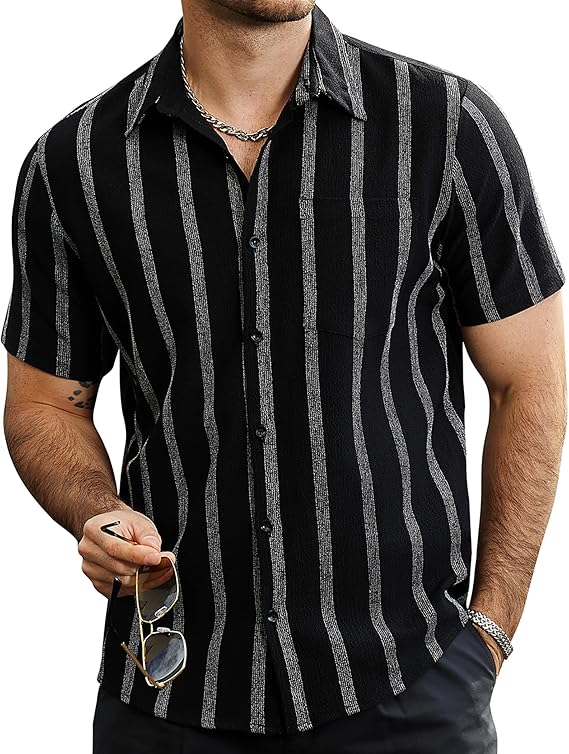Shirt Size Conversion Chart – US, UK, EU, and International Sizing Explained
Choosing the right shirt size can often feel like a guessing game. With different countries using different sizing systems, it can be difficult to determine which shirt will fit perfectly. Whether you’re shopping online or traveling internationally, understanding shirt size conversions is crucial for ensuring a comfortable and flattering fit.
We’ll break down the common shirt sizing systems used in the United States (US), United Kingdom (UK), European Union (EU), and other international markets. We’ll also provide a helpful shirt size conversion chart to guide you through the process and answer common sizing-related questions. By the end of this post, you’ll be equipped to navigate shirt size differences and choose the right size with confidence.
The Shirt Size Sizing Systems
Shirt sizes are typically based on chest measurements, but they can also vary depending on the region and brand. Most systems use either numbers (like 38 or 40) or letters (like S, M, L, and XL), but the actual measurements of these sizes can differ significantly between countries.
Here’s a quick overview of how some of the most commonly used sizing systems work:
US Shirt Sizes
In the United States, shirt sizes are usually labeled using numbers or letters. For men’s shirts, the size is often based on neck circumference and sleeve length. For example, a shirt size of 16 ½ (neck measurement) and 32-33 (sleeve measurement) means the shirt is designed for someone with a neck circumference of 16.5 inches and a sleeve length of 32 to 33 inches.
For women’s shirts, the system tends to use numbers, with common sizes being 2, 4, 6, 8, 10, and so on. However, like men’s sizes, the fit can vary between brands.
Looking for the perfect fit? Check out these Best-Selling Shirts.






UK Shirt Sizes
UK sizing is similar to US sizing but with some subtle differences. For example, a UK size 12 is roughly equivalent to a US size 8. In general, UK sizes tend to be slightly smaller compared to US sizes.
For men’s shirts, sizes are often labeled in measurements of the neck and sleeve length, just like in the US. Women’s sizes use a similar numbering system but can also have a distinct fit.
EU Shirt Sizes
The European sizing system uses a number-based system, with sizes typically ranging from 38 to 60 for men and women. Unlike the US and UK, EU sizes are more standardized and focus on chest measurements, making it easier to understand the actual fit of the shirt. However, EU sizes can still vary slightly between different countries.
For instance, an EU size 40 shirt typically corresponds to a US size 4 for women, but this can vary based on the brand.
Read More: How to Buy Shirts Online Without Sizing Mistakes
International Shirt Sizes
International shirt sizes can differ from region to region. Many countries, especially in Asia, have their own sizing systems that may not directly correlate with the US, UK, or EU systems. For example, Japan and China use their own size charts that can often appear smaller compared to Western sizing systems.
When buying shirts from international brands, it’s important to consult their specific size charts or conversion guides to ensure an accurate fit.
Shirt Size Conversion Chart: US, UK, EU, and International
To simplify the process of selecting the right shirt size, here’s a comprehensive shirt size conversion chart that compares US, UK, EU, and international sizes. This chart includes both men’s and women’s sizes, along with chest measurements to make conversions easier.
Men’s Shirt Size Conversion Chart
| US Size | UK Size | EU Size | Chest Measurement (inches) |
|---|---|---|---|
| XS | XS | 44 | 34-36 inches |
| S | S | 46 | 36-38 inches |
| M | M | 48 | 38-40 inches |
| L | L | 50 | 40-42 inches |
| XL | XL | 52 | 42-44 inches |
| XXL | XXL | 54 | 44-46 inches |
| XXXL | 3XL | 56 | 46-48 inches |
| 4XL | 4XL | 58 | 48-50 inches |
| 5XL | 5XL | 60 | 50-52 inches |
Women’s Shirt Size Conversion Chart
| US Size | UK Size | EU Size | Chest Measurement (inches) |
|---|---|---|---|
| 0-2 | 4-6 | 32-34 | 30-32 inches |
| 4-6 | 8-10 | 36-38 | 32-34 inches |
| 8-10 | 12-14 | 40-42 | 34-36 inches |
| 12-14 | 16-18 | 44-46 | 36-38 inches |
| 16-18 | 20-22 | 48-50 | 38-40 inches |
| 20-22 | 24-26 | 52-54 | 40-42 inches |
| 24-26 | 28-30 | 56-58 | 42-44 inches |
| 28-30 | 32-34 | 60-62 | 44-46 inches |
👕 Toddler Shirt Size Conversion Chart
| Age | US Size | UK Size | EU Size | Height (in/cm) | Weight (lbs/kg) |
|---|---|---|---|---|---|
| 12 Months | 12M | 12M | 80 | 29–30 in / 74–76 cm | 20–22 lbs / 9–10 kg |
| 18 Months | 18M | 18M | 86 | 31–32 in / 78–81 cm | 23–25 lbs / 10.5–11.5 kg |
| 24 Months | 24M | 1.5–2 Y | 92 | 33–35 in / 83–89 cm | 26–28 lbs / 12–13 kg |
| 2–3 Years | 2T–3T | 2–3 Y | 98–104 | 36–39 in / 91–99 cm | 28–33 lbs / 13–15 kg |
| 3–4 Years | 4T | 3–4 Y | 104–110 | 39–42 in / 99–107 cm | 33–37 lbs / 15–17 kg |
| 4–5 Years | 5T | 4–5 Y | 110–116 | 42–45 in / 107–114 cm | 37–42 lbs / 17–19 kg |
Common Shirt Size FAQs
1. What is the difference between US and UK shirt sizes?
The primary difference between US and UK shirt sizes is that UK sizes tend to run smaller. For example, a US size 8 would be roughly equivalent to a UK size 12. This difference is most noticeable in women’s clothing.
2. How do I know my shirt size?
To determine your shirt size, you’ll need to measure your chest circumference and sleeve length (for men’s shirts) or your bust measurement (for women’s shirts). You can then match your measurements to the size charts for each country or brand.
3. Are European sizes the same as UK sizes?
No, European and UK sizes are not the same. EU sizes tend to be larger, with European sizes typically starting around size 38, while UK sizes start around size 6 or 8. It’s essential to check the specific conversion chart for each brand.
4. Why do international shirt sizes vary?
International shirt sizes vary due to different sizing standards in different countries. For instance, US and UK sizes are based on neck and chest measurements, while European sizes focus on chest measurements alone. Additionally, some regions, like Asia, use entirely different systems based on body proportions.
5. Do shirt sizes differ between brands?
Yes, shirt sizes can vary slightly from one brand to another. This is why it’s essential to consult the specific brand’s size chart before making a purchase, especially if you are shopping online.
6. How do I convert my shirt size for international shopping?
To convert your shirt size for international shopping, find a reliable conversion chart that compares sizes from the US, UK, EU, and other international markets. Measure your chest, bust, and sleeve length and compare them to the measurements provided in the chart.
7. What if I’m between sizes?
If you’re between two sizes, it’s generally better to go with the larger size for a more comfortable fit. However, consider the brand’s sizing and style—some shirts are designed for a slim fit, while others offer a looser, more relaxed fit.
Tips for Shopping Online and Internationally
Shopping for shirts online can be a bit tricky, especially when buying from international brands. Here are some tips to help you make the right choice:
- Check size charts: Always refer to the brand’s specific size chart before making a purchase. Don’t assume that your usual size will fit the same way.
- Read customer reviews: Customer reviews often mention whether a shirt runs large or small, which can help you decide which size to order.
- Measure yourself: Use a flexible tape measure to measure your chest, waist, and sleeve length. Having your measurements on hand will make it easier to select the right size.
- Consider the fit: Shirts come in different fits regular, slim, and loose so take that into account when choosing your size.
- Look for return policies: Ensure that the store has a good return or exchange policy, especially if you’re unsure about the fit.
Conclusion
Navigating shirt sizes across different countries can be confusing, but understanding how US, UK, EU, and international sizing systems differ can help you find the perfect shirt. Whether you’re shopping locally or internationally, always check the size charts and take your measurements to make informed decisions. With the right size, you’ll not only feel more comfortable but also look your best!
Keep this guide handy, and the next time you shop for shirts, you’ll be ready to make confident size choices no matter where you are or where you’re shopping from.
This post aims to demystify shirt size conversions and make shopping for the right fit easier. Whether you’re buying online, traveling, or just curious about sizing differences, the chart and tips provided should help guide your choices. Happy shopping!
This Tool





